|
| |
Archives
zorki standard
I've been out shooting with the Zorki Standard. I'm *really* liking it. I picked up my broken FED 2 the other day and hadn't realized how much bigger it was compared to the Zorki Standard. The little Zorki is really small and light. I'm also getting used to using the Gordodot wireframe. I'm liking it, too. Even though the Gordodot is working fine, the esthetics do leave a little to be desired. The base is visually to bulky, the wireframe is on at a slight angle, which really doesn't affect anything, but I've been wanting to do something about it. And the black put on by the Sharpie Magic Marker wasn't that magic. It comes off but it let me know that the wireframe wants to be black. I finally found the metal foot that I bought some time ago to replace the plastic foot on my Vivitar 283.
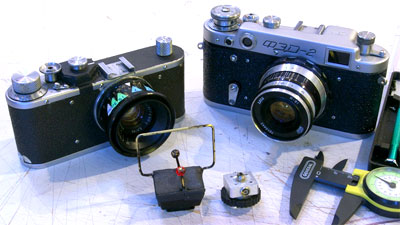
It never made it on the 283 and I've moved up to a Metz C-45 so it is never going to be going on the 283. You can get them on eBay for under $10. Search for Vivitar 283 foot.
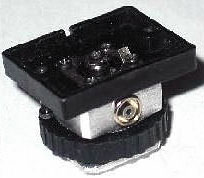
I removed the plastic top. The next step is to drill out the flash bits in the center, drill some holes to insert the wireframe, file the metal down a bit, paint it black and I will have the improved, and lower profile, Gordodot Mark II.
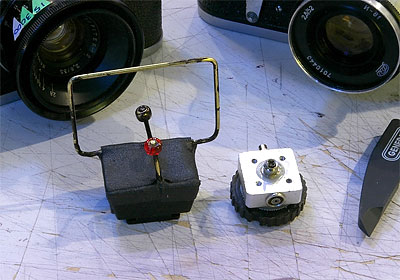
The paper shutter mechanism cover is temporary. I've developed the shape for a permanent shutter mechanism cover. I took a photo of the top of the camera and then printed it out large on a piece of paper. I can convert measurements taken on the print and scale them down. This makes it much easier and a lot more accurate than directly measuring the camera. The width of the camera body is the reference dimension. There is some motion of the cam so I have two pictures superimposed showing the full range of motion. (Digital does come in handy.) Add a little clearance and there is the plan view.
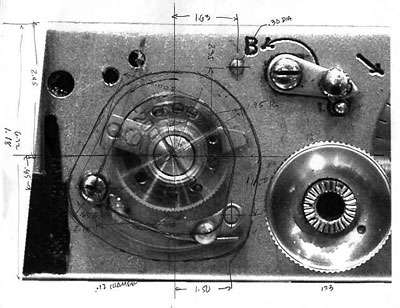
It turns out that most of the dimensions I wrote down weren't needed. (Some are even wrong. I'm not saying which. ) I scaled some points off of the pencil sketch (above) and drew it up on my CAD program. I saved it as a bmp file and brought it back into Photoshop to check clearances. It needed a little tweaking.
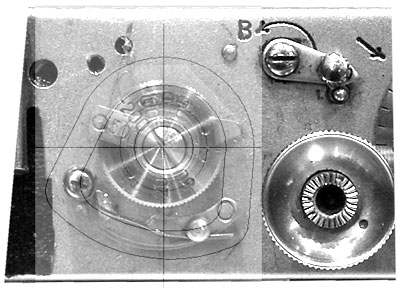
Then I put a filled in version on the photograph to get a better idea what it would look like. It's going to be small.

Now to find an appropriate piece of wood, print out the drawing, glue it on top of the wood, and start removing wood. When the wood shape is done I will use it as a form to hammer form soft soft aluminum into the final shape.
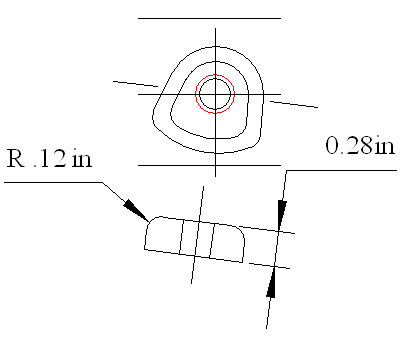
The hole in the wood is for some 1/2 threaded rod to hold on to the little sucker with. The red circle is the clearance hole that will be in the cover. I've been planning on hammer forming aluminum but this could be used as a form for fiberglass, too. Or how about a carbon fiber covering?
plamegate
And let us not forget that Scooter Libbey's trial is about to begin, trying him for leaking the identity of CIA agent Valerie Plame. Which was probably done at the instigation of his boss Vice President Dick Cheney.
CIA Leak Probe: Inside The Grand Jury
|
On January 16, Libby will go on trial in the federal courthouse in Washington D.C. on five counts of lying to federal investigators, perjury, and obstruction of justice. He is accused of attempting to conceal his role, and possibly that of others, in leaking to the media that Wilson's wife, Valerie Plame, was a CIA officer, and that she might have played a role in sending her husband on a CIA-sponsored mission to Niger in 2002 to determine whether Saddam Hussein had attempted to procure uranium from Niger to build a nuclear weapon.
In attempting to determine Libby's motives for allegedly lying to the FBI and a federal grand jury about his leaking of Plame's CIA identity to journalists, federal investigators theorized from the very earliest stages of the case that Libby may have been trying to hide Cheney's own role in encouraging Libby to discredit Wilson, according to attorneys involved in the case.
Cheney is scheduled to be a defense witness in the Libby trial. Regarding this, a spokesperson for the Vice President says: "We've cooperated fully in this matter and will continue to do so in fairness to the parties involved."
Both Cheney and Libby have repeatedly denied -- both publicly and to federal investigators -- that Cheney ever encouraged Libby specifically to leak information to the press about Plame. But since the early days of the leak probe in fall 2003, even before it was taken over by Special Prosecutor Patrick Fitzgerald, investigators have maintained that Libby devised an elaborate cover story even though he must have known that contemporaneous records and the testimony of others was very likely to show that he was lying. Other than the motive to protect himself, the only other driving force behind Libby's actions, federal investigators have theorized, was to protect Cheney or other superiors, according to attorneys who have been involved in the CIA leak probe.
| |
[more]
movie recommendation
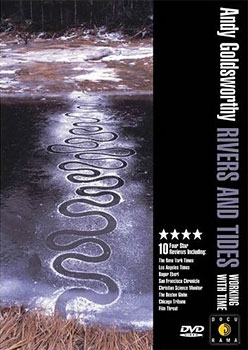
Rivers & Tides:
Working with Time
Andy Goldsworthy
Marja-Leena turned me on to this one. I've been a fan of Goldworthy for some time. His work in ephemeral sculpture is breathtaking. He is almost as much photographer as sculpture since it is only with photography that much of his work can be seen. His work with rock is also amazing. This DVD shows him at work (it sure looks more like play) and we are also able to see the dynamic qualities of some of his work. It's amazing watching him going for a walk and stopping to pick bright yellow flowers and then, at the end of his walk, arrange them in nature to make a thing of beauty that will, in hours or days, vanish. You must see this. From Amazon:
|
Andy Goldsworthy's Rivers and Tides is a truly beautiful, Scottish-German 2001 documentary about artist Goldsworthy, a Scotsman whose medium is nature itself and whose preferred studio is the outdoors, particularly where water forever flows, rises, and/or retreats. The soft-spoken, secluded Goldsworthy is seen hard at work making ephemeral sculptures out of bits of ice in the trees, or building tall, mysterious cones from loose rock, which stand like spiritual sentinels in forests and on shorelines, overgrown by plants or swallowed daily by high tides. Filmmaker-cinematographer Thomas Reidelsheimer goes to great and sometimes inexplicable lengths to make visual corollaries to Goldsworthy's ideas about underappreciated relationships between light, color, movement, balance, and fluidity of form in the real world, making Rivers and Tides a lively and always surprising cinematic gallery. Some of Goldsworthy's most miraculous natural installations--stone walls that snake through hundreds of feet of forest and stream, for instance--show up in the last half-hour.
| |
Andy Goldsworthy
From Wikipedia, the free encyclopedia
Image search with Google
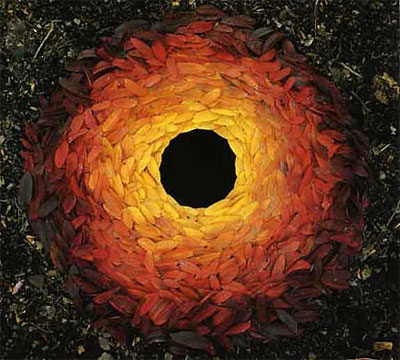
[more]
iraq
Bush's new strategy - the march of folly
So into the graveyard of Iraq, George Bush, commander-in-chief, is to send another 21,000 of his soldiers. The march of folly is to continue...
by Robert Fisk
|
There will be timetables, deadlines, benchmarks, goals for both America and its Iraqi satraps. But the war against terror can still be won. We shall prevail. Victory or death. And it shall be death.
President Bush's announcement early this morning tolled every bell. A billion dollars of extra aid for Iraq, a diary of future success as the Shia powers of Iraq still to be referred to as the "democratically elected government" march in lockstep with America's best men and women to restore order and strike fear into the hearts of al-Qa'ida. It will take time oh, yes, it will take years, at least three in the words of Washington's top commander in the field, General Raymond Odierno this week but the mission will be accomplished.
Mission accomplished. Wasn't that the refrain almost four years ago, on that lonely aircraft carrier off California, Bush striding the deck in his flying suit? And only a few months later, the President had a message for Osama bin Laden and the insurgents of Iraq. "Bring 'em on!" he shouted. And on they came. Few paid attention late last year when the Islamist leadership of this most ferocious of Arab rebellions proclaimed Bush a war criminal but asked him not to withdraw his troops. "We haven't yet killed enough of them," their videotaped statement announced.
Well, they will have their chance now. How ironic that it was the ghastly Saddam, dignified amid his lynch mob, who dared on the scaffold to tell the truth which Bush and Blair would not utter: that Iraq has become "hell" .
| |
[more]
Reality Check
bty Steve Gilliard
|
Bush's plan is a fantasy, a dangerous one which also provokes Iran to no good purpose.
1) While the Iraqis made a lot of promises and big talk, remember ONE thing. Moqtada Sadr hung Saddam Hussein. Not the government, and they had to go along. So any threat from Maliki should be taken as a threat from Kerensky to tell Lenin that Trotsky needs to control the Bolsheviks
2) Sadr has already manuvered his way past Washington's coup and had brutally demonstrated his power
3) There is no effective Iraqi government to impliment any program. No matter how much money you give to them, they will either steal it or not use it.
4) While Maliki talks unity government, his plan for securing Baghdad basically means attacking Sunni neighborhoods.
5) Sadr fully expects a surge. Fully. According to NPR, he's handing out grenades to every home and drafting every swinging dick between 15 and 45.
| |
[more]
The Fatal Flaw...
by Pat Lang
|
3- The Political Action part of this plan is where the whole scheme is going to collapse. In "Bushworld" the Maliki "government," sheltered behind American troops in the Green Zone is somehow the equivalent of George Washington's "infant" first administration in that it is groping toward a consolidation of its power in the context of a true regard for the interests of the various peoples of Mesopotamia and Kurdistan. In "Bushworld" all that is needed is to be sufficiently encouraging and mentoring with Maliki and his ministers to "jump start" the functions of a federal state endowed with a reasonably strong central government. In "Realworld" Maliki is merely another Shia Arab activist seeking to consolidate Shia Arab control over as much of the old Iraq as can be managed. In "Realworld" Maliki can not suppress the Shia militia leaders because he is their brother, embarked on the same quest for Shia power. In "Bushworld" we have asked the Maliki government to participate with us in fighting, if necessary, (and it will be) the Mahdi Army of Moqtada al-Sadr. In "Realworld" Sadr is an ally from whom Maliki may not distance himself, because he and Sadr represent the same cause. Think not? Think about Saddam's execution. Think about it. Who ran the execution? Who set the terms and circumstances? Was it Maliki?
| |
[more]
Meanwhile, in Baghdad
|
A Shiite political leader who has worked closely with the Americans in the past said the Bush benchmarks appeared to have been drawn up in the expectation that Mr. Maliki would not meet them. "He cannot deliver the disarming of the militias," the politician said, asking that he not be named because he did not want to be seen as publicly criticizing the prime minister. "He cannot deliver a good program for the economy and reconstruction. He cannot deliver on services. This is a matter of fact. There is a common understanding on the American side and the Iraqi side."
Views such as these — increasingly common among the political class in Baghdad — are often accompanied by predictions that Mr. Maliki will be forced out as the crisis over the militias builds. The Shiite politician who described him as incapable of disarming militias suggested he might resign; others have pointed to an American effort in recent weeks to line up a “moderate front” of Shiite, Sunni and Kurdish political leaders outside the government, and said that the front might be a vehicle for mounting a parliamentary coup against Mr. Maliki, with behind-the-scenes American support.
| |
[more]
thanks to Talking Points Memo
book recommendations
 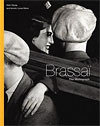
Here are a couple of early 20th century French photographers. Jacques Henri Lartigue, Photographer and Brassaï: The Monograph. Lartigue and Brassaï are both essential. Wonderful to look at and lots to learn from.
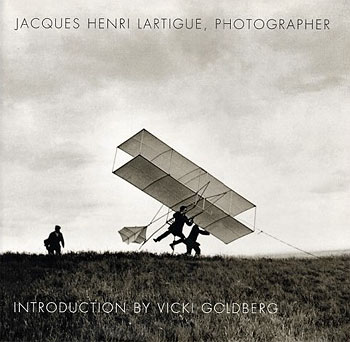
Jacques Henri Lartigue, Photographer
by Jacques-Henri Lartigue
Lartigue is amazing. There is a childlike quality to his pictures; not childish, but childlike. His pictures are filled with wonder and curiousity. From Amazon:
|
When French photographer Jacques Henri Lartigue (1894-1986) was eight, his father gave him a camera. This monograph displays the enchanting images taken by the youthful photographer during the first three decades of the 20th century. Here, 126 striking duotone pictures, with captions by Lartigue himself, portray his privileged lifestyle with family, friends, and the leisure class, including remarkable shots of fashionable women of the belle ?poque. Fascinated by movement, Lartigue captured people, objects suspended in space, early attempts at aviation and motoring, and athletes pushing the limits of endurance in images containing a carefree exuberance almost unrivaled in photography. Personal tragedies and a world at war are noticeably absent.
| |
Jacques Henri Lartigue
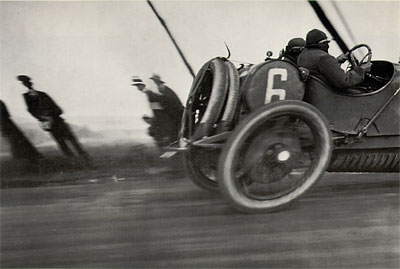
[more]
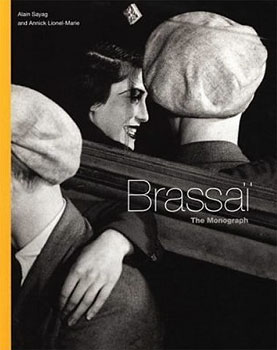
Brassaï:
The Monograph
by Brassaï
Brassaï was actually from Transylvania but became a French citizen. Where Lartigue photographed the rich, Brassaï photographed the street walkers and brothels at night. From Amazon:
|
"The meaning of art is not authenticity but the expression of authenticity," wrote the Hungarian-born photographer Gyula Halász, better known as Brassaï, whose unflinching yet deeply sensual portraits of the seamier side of Paris nightlife during the 1930s and 1940s summon up an era when decadence and desperation ran side by side. Brassaï's curiosity about his subjects and the originality of his approach highlight the depth of his identification with Paris, his adopted city. The son of a professor of French literature, Brassaï had first visited the city at the age of 5; later, in the early 1920s, he returned to make it his home after completion of studies in fine art in Budapest and Berlin. Settling in the bohemian arrondissement of Montparnasse, mixing with artists and writers, Brassaï took up photography "in order to capture the beauty of streets and gardens in the rain and fog, and to capture Paris by night." He lures us into the smoky, highly charged world of clubs and cafés, where nicotine-stained lovers in cheap clothes become impossibly desirable through the camera's lens. Streets, stairways, and canals are moodily lit; even a man rummaging for food in a rubbish bin takes on a cinematic aura. Yet Brassaï's photographs contain a strange mixture of seediness and resilience that ultimately triumphs over any false notions of glamour. He depicts scenes of poverty and its trappings--alcoholism, prostitution, violence, hunger. The chaotic social whirl of 1930s Paris dies down to the quiet suffering of a city under occupation, with its two great literary lights, Jean-Paul Sartre and Simone de Beauvoir, sitting out the war, stony-faced in the Café de Flore. Accompanied by extracts from Brassaï's own writings, contemporaries such as Henry Miller, and essays from other contributors, and containing 308 images, Brassaï is a fine testament to an artist whose images of one city have proved so enduring.
| |
Brassaï
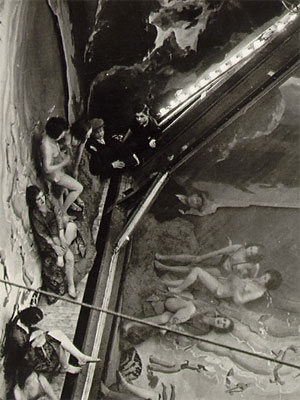
[more]
|
|
|
|
















